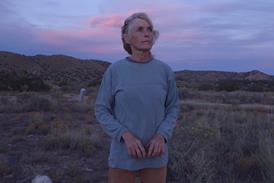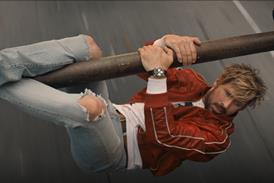Dir: Gus Van Sant. US-UK. 2001. 103mins.
After reaching the nadir of his career with the pointless remake of Psycho, followed by mainstream Hollywood fare Finding Forrester, an old-fashioned star vehicle for Sean Connery, Gus Van Sant goes back to his independent roots with Gerry, a visually compelling road movie that recalls his most distinctive work, My Own Private Idaho. In its rigorously austere artistry, Gerry is a minimalist film that carries itself mostly through its awesome, often transcendent, visuals and sounds. The film represents a reunion for Van Sant with Matt Damon after their terrific collaboration on Good Will Hunting and also offers a wonderful role for Casey Affleck (who played a small role in that 1997 Oscar-winning film). Since the new narrative is slight, marked by sparse and sporadic dialogue (even by the standards of experimental independent film-making), Gerry comes across as a semi-academic film that will be embraced by film scholars and cerebral, fringe audiences seeking non-traditional fare. The film, which received its world premiere at the Sundance film festival, should travel the global festival circuit, where it is bound to please avid film lovers, before receiving a limited theatrical release by an entrepreneurial, risk-taking distributor.
Pushing 50, and at a midpoint in his career, the ever-unpredictable and immensely talented Van Sant has made a film that at once signals and benefits from what is obviously an artistic crisis and need to revitalise his creative juices. Having followed the commercial route, which began with Good Will Hunting, Van Sant has made a radical departure with Gerry, a film that is just as innovative and fresh as his first works (Mala Noche, Drugstore Cowboy), albeit in a very different way.
The central premise, which is replete with complex symbolic and metaphysical meanings, is rather simple. Two young men, both named Gerry (Damon and Affleck), go on a hike in a remote desert (the film was mostly shot in Death Valley, California) that tests their identities and intimate camaraderie. Ultimately it also tries their very existence, as the trip forces them to come to terms with the brutality of nature and the elements, and their most basic survival instincts, due to a lack of food, shelter and water.
In the first long tracking shot, the camera follows a car from behind as it rides down a isolated road, before switching angle and presenting the viewers with the faces of the two protagonists. Violating every rule of classic narrative cinema, Van Sant shrewdly and deliberately avoids providing any clues as to who the characters are or their backgrounds, motivations or value systems. Indeed, it takes a long time before any verbal communication takes place between the two men. This verbal minimalism continues throughout the picture, forcing the viewers to speculate about the protagonists as their trip begins to go awry before reaching its tragic, but extremely logical, and emotionally satisfying denouement.
Although the film has a blueprint, the screenplay, credited to Van Sant and his two actors, feels improvised. For the most part it rings true: what the Gerrys talk about, on the rare occasions when they choose to interact, makes sense, reflecting their escalating concern with dehydration and fear of getting lost in the wilderness after they lose the spot where they left their car.
Despite the strong physical presence of Damon and particularly Affleck, Gerry is very much an auteurist director's film, one that employs to marvellously resourceful effect the basic syntax of film language, such as ever-changing points of view, and the mixture of long, static takes with medium-range shots. Cerebral critics will get a kick out of observing how Van San utilises and manipulates cinema's two most distinctive dimensions: space and time. Discerning viewers will find themselves speculating throughout the film about the distance and angle from which the Gerrys and the awesome vistas are visually presented.
Perhaps most impressive of all is Van Sant's stubborn refusal to grant his actors close-ups, Hollywood's most common device for eliciting the audience's emotional identification with a story's central characters, and displaying the stars` screen presence. One can count on one hand the number of close-ups in Gerry, most of which appear towards the end of journey, although there is not a single big close-up.
The most variable elements in Gerry are the awesome landscape and the positioning of the two characters, both alone and together, against it. While the changing landscape, magnificently presented at different times of the day (and night) enriches the film visually, it also presents some problems: one third of the film was shot in Argentina, but then relocated to California's spectacular Death Valley because of worsening climate conditions.
The other variable dimensions are the film's ever changing mood and tone, which becomes progressively darker and more sombre. Some audiences may find the second reel particularly entertaining due to its eccentric humour. This derives from a revelatory shot in which Affleck stands atop a single, isolated cliff, with Damon below him on the ground, waiting and preparing for him to jump. It's in these segments that Gerry recalls works by silent clowns such as Chaplin and Buster Keaton and comedies by French auteur Jacques Tati.
In its good, resonant moments, which are plentiful, Gerry comes across as a stark existential fable, very much in the tradition of Samuel Beckett's plays, specifically Waiting For Godot. Like Beckett's (anti) heroes, the two Gerrys are clowns seeking meaning for their routine existence, while utterly lost, both literally and figuratively, in the wilderness.
Early on in his career, Van Sant was justifiably labelled as the American Jean Genet, the French enfant terrible man of letters. In many significant ways, both thematically and philosophically, Gerry fits into the entire oeuvre of Van Sant, who has devoted his career to journeys about misfits and outcasts that explore the most bizarre yet random nature of life. Gerry is not as lyrical or fanciful as My Own Private Idaho, arguably Van Sant's masterpiece, but like that 1991 landmark independent film, it centres on the changing relationship between two "deviant" personalities.
Van Sant holds that Gerry pays homage to such seminal figures as Hungarian filmmaker and theorist, Bela Tarr, Belgian experimental director Chantal Akerman and celebrated Iranian auteur Abbas Kiarostami (whose Taste Of Cherry won the 1997 Cannes Palme D'Or. However, strategically and visually, Gerry is also influenced by Italian master Michelangelo Antonioni and Greek film-maker Theo Angelopoulos, whose films are odysseys of one kind or another into the countryside of bleak Greek existence, burdened by the past. In its rigorously austere, utterly controlled artistry and cool Brechtian distancing - the film is devoid of facile emotionalism - Gerry recalls Angelopoulos' work. The feature is necessarily languid and preoccupied with the duration and composition of shots. The shifts in perspective, the progress (or lack of) of the journey (depending on how looks at it), and the movement all result in a film that serves as a metaphor for understanding self and other.
Although favouring alterable camera movement and long takes, Gerry differs from Angelopoulos' work in its acting style, an Amer


















No comments yet